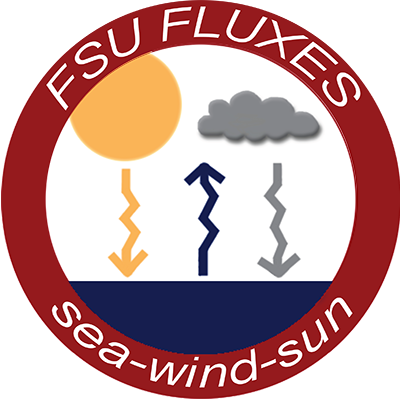The FSU IN SITU FLUXES are monthly averaged fields of surface turbulent fluxes (stress, sensible heat, and latent heat) as well as related variables (scalar averaged wind speed, wind averaged winds, sea surface temperature, air temperature, and humidity). The wind speeds, air temperature, and humidity are referenced to a height above the water surface of 10m. These variables all change as a function of height above the surface, therefore it is necessary to specify the reference height. Note that the WMO defines surface wind as the wind measured at 10m above the surface.
The FSU2 is
- winds only,
- on 2x2 degree grid, and
- for the equatorial Pacific.
The FSU3 product has
- Surface turbulent fluxes and related variables,
- Radiation from Bill Rossow and Yaunchong Zhang's ISCCP product,
- A 1x1 degree grid,
- Current is available for the Atlantic and Indian Ocean basins, and
- Will soon contain uncertainties.
Direction conventions:
Meteorologists and oceanographers often apply different conventions for the direction of fluxes. The convention that we use is that positive stress indicates the transfer of eastward or northward momentum from the atmosphere to the ocean. Positive heat fluxes indicate energy from the ocean being transferred to the atmosphere.
Flux Model and Transfer Coefficients:
The flux model used in our objective analysis is based on Bourassa (2006). It is a computationally efficient version, which retains the vast majority of the physically based variability in the full model (manuscript in preparation).
Bourassa, M. A., 2006: Satellite-based observations of surface turbulent stress during severe weather, Atmosphere - Ocean Interactions, Vol. 2., ed., W. Perrie, Wessex Institute of Technology Press, 35 - 52 pp.
Biases:
Information on biases is anticipated, but not yet available.
Uncertainties:
Information on random errors (uncertainty) is anticipated, but not yet available. We plan to release fields of uncertainty for surface turbulent fluxes and all related variables.
Radiation Data:
The surface radiation data, available in parallel to the FSU IN SITU FLUXES data set, is a subset of Bill Rossow and Yuanchong Zhang's ISCCP-FD monthly (MPF) radiation data set (Zhang et al. 2004). The native grid for the monthly radiation data is 2.5 degrees. Those fields are interpolated to the grid used for the ship data.
Zhang, Y-C., W.B. Rossow, A.A. Lacis, V. Oinas, and M.I. Mishchenko, 2004: Calculation of radiative fluxes from the surface to top of atmosphere based on ISCCP and other global data sets: Refinements of the radiative transfer model and the input data. J. Geophys. Res., 109, doi:10.1029/2003JD004457.
Anticipated Applications (we welcome feedback):
FSU IN SITU FLUXES:
- Climate Modeling
- Seasonal or monthly changes
- Interannual variability
- Decadal variability (we are working to lengthen the time series)
- Semi-coupled forcing using atmospheric variables only
- Large Scale Ocean Modeling
- Integrating large domains over long time periods
- ENSO studies
- NAO and AMO studies
- Monsoon variability
- Process Studies
- Influences of the surface forcing terms
- And many more
FSU SATELLITE FLUXES:
- Process Studies
- Identification of transient ocean forcing and heat fluxes
- Cyclone evolution
- Influences of finer scale variability
- Large Scale Ocean Modeling
- Integrating large domains over long time periods
- ENSO studies
- NAO and AMO studies
- Monsoon variability




